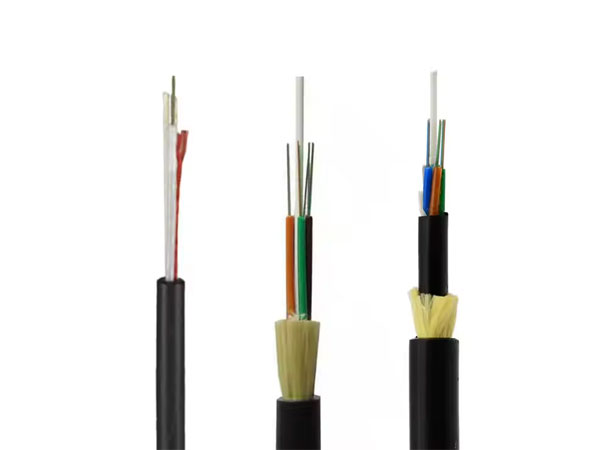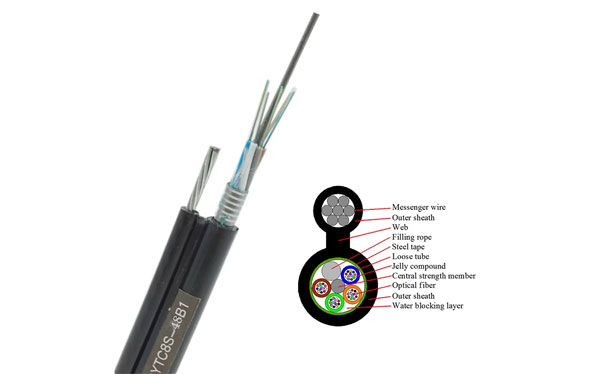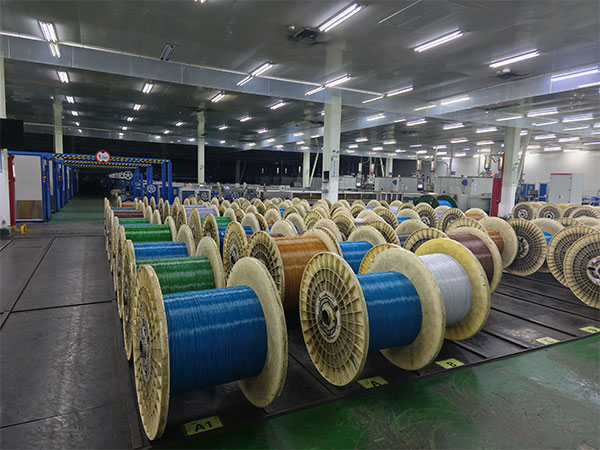When planning an aerial fiber optic network, choosing the right cable type is critical to ensuring reliability, cost-efficiency, and long-term performance. Two popular options—ADSS (All-Dielectric Self-Supporting) and Figure-8 Fiber Cable—often come into the spotlight. While both are designed for overhead installations, their structural differences and use cases can significantly impact your project’s success. Let’s break down their strengths, limitations, and ideal applications to help you make an informed decision.

ADSS Fiber Cable
ADSS is a self-supporting, all-dielectric cable that requires no separate messenger wire. Its core strength comes from non-metallic materials like glass-reinforced plastic (GRP) or aramid yarn, making it immune to corrosion and electromagnetic interference (EMI). ADSS is engineered for long spans, harsh environments, and installations near power lines.
Figure-8 Fiber Cable
Figure-8 cable, named for its distinctive “8”-shaped cross-section, combines optical fibers with an integrated steel messenger wire. The steel wire provides mechanical support, allowing the cable to be strung between poles. It’s a cost-effective solution for shorter spans and less demanding environments.
Key Differences at a Glance
Feature ADSS Fiber Cable Figure-8 Fiber Cable
Structure All-dielectric, no metal components Integrated steel messenger wire
Weight Lightweight Heavier due to steel reinforcement
Corrosion Resistance Immune to rust and EMI Steel wire prone to corrosion over time
Installation Complexity Requires specialized hardware and planning Simpler, faster to install
Span Length Supports longer spans (up to 1 km+) Best for shorter spans (<500 meters)
Cost Higher upfront cost, lower lifetime TCO Lower initial cost, higher maintenance
Environmental Suitability Ideal for extreme weather, coastal areas, and high-voltage zones Suitable for mild climates and urban/rural deployments
ADSS vs. Figure-8: Which Should You Choose?
1. When to Opt for ADSS Fiber Cable
Long-Span Deployments: ADSS excels in scenarios requiring spans exceeding 500 meters, such as crossing rivers, valleys, or highways.
Harsh Environments: Its all-dielectric design resists corrosion from saltwater, humidity, and industrial pollutants, making it perfect for coastal regions, chemical plants, or areas with high EMI.
Power Line Proximity: ADSS can be installed alongside high-voltage power lines without risk of electrical interference or grounding issues.
Low Maintenance Needs: With no metal to corrode, ADSS minimizes long-term upkeep and replacement costs.
2. When Figure-8 Fiber Cable Fits Better
Budget-Conscious Projects: Figure-8 is typically cheaper upfront, ideal for short-span deployments in urban or rural areas with limited budgets.
Simpler Installations: The integrated messenger wire simplifies setup, reducing labor time and hardware requirements.
Temporary or Short-Term Deployments: For projects with a shorter lifecycle, Figure-8 offers a practical balance of performance and affordability.
Mild Climates: In regions without extreme weather or corrosive elements, Figure-8 provides reliable service at a lower cost.

Critical Considerations for Your Decision
Environmental Factors
-
ADSS dominates in corrosive or high-EMI environments.
-
Figure-8 may require additional protective coatings in humid or coastal areas to delay steel corrosion.
-
Span Length and Load Capacity
-
ADSS handles longer spans and heavier wind/ice loads.
-
Figure-8’s steel wire can sag under excessive weight over long distances.
Future-Proofing
ADSS offers superior durability for long-term infrastructure, aligning with 5G, smart grid, and FTTH expansions.
Figure-8 may need upgrades or replacements sooner in demanding conditions.
Safety and Compliance
ADSS eliminates electrical hazards near power lines, complying with strict safety standards.
Figure-8’s steel wire requires proper grounding to avoid risks in energized environments.
Real-World Scenarios
Rural Broadband Expansion: A telecom provider in a coastal area chose ADSS to avoid saltwater corrosion and ensure 20-year longevity.
Urban Last-Mile Connectivity: A municipality deployed Figure-8 for cost-effective aerial links between street poles in a dry, temperate climate.
Power Utility Upgrades: An energy company adopted ADSS for power line communication (PLC) networks, avoiding EMI issues with high-voltage lines.
The Verdict
-
There’s no one-size-fits-all answer—the choice depends on your project’s unique demands:
-
ADSS Fiber Cable is the superior choice for longevity, extreme environments, and high-reliability applications.
-
Figure-8 Fiber Cable suits shorter spans, tighter budgets, and moderate climates.

Still Unsure? Let’s Find Your Perfect Fit!
Whether you prioritize lifespan, cost, or environmental resilience, our experts can guide you in selecting the optimal aerial fiber solution.
Contact us today to discuss your project requirements and unlock a future-proof network!
[Hunan GL Technology Co., Ltd] – Empowering Smarter, Stronger Connections.



